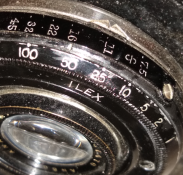jay moussy
Member
A friend of the family gave me this camera. time to put some film in it!
The aperture dial reads 7.5, 8, 11, 16, 22, 32, 45.
Are these our modern-day f numbers?
(for reference shutter speed range is 1/100 to one sec, plus T, B)
Bonus question: the film backing provision are thin, 1/4 inch wide blades, upper and lower. like so:
____________________ Film
_ _ "blades"
____________________ Body back
I will need to supplement that for the 120 film size.
should I just add wider strips on the "blades"
I think there should be added support on emulsion side, as the gate is 65 mm wide.
The aperture dial reads 7.5, 8, 11, 16, 22, 32, 45.
Are these our modern-day f numbers?
(for reference shutter speed range is 1/100 to one sec, plus T, B)
Bonus question: the film backing provision are thin, 1/4 inch wide blades, upper and lower. like so:
____________________ Film
_ _ "blades"
____________________ Body back
I will need to supplement that for the 120 film size.
should I just add wider strips on the "blades"
I think there should be added support on emulsion side, as the gate is 65 mm wide.







